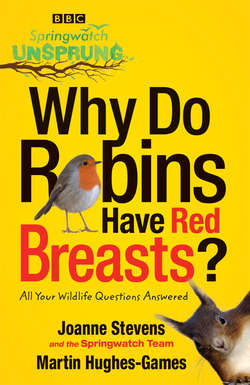Читать книгу Springwatch Unsprung: Why Do Robins Have Red Breasts? - Jo Stevens - Страница 30
Pitching Up
ОглавлениеI was driving to Brecon in south Wales last week and saw several colonies of tent-making caterpillars. The colonies were all very large, a metre or so long. Some of the colonies had completely stripped the hedgerow for long stretches and all that was left was twigs and silk. Are these native to the UK (I have seen very much smaller colonies on hawthorn) or are they an invasive species? Rob
There are quite a few native species of moths and butterflies whose caterpillars make tents, such as the lackey moth (Malacosoma neustria) and marsh fritillary butterfly (Euphydryas aurinia). However, the impressive size and extent of the tents that Rob describes suggests that they were made by one of our eight species of ermine moth that belong to the genus Yponomeuta.
The adult moths are fairly inconspicuous, with white or grey wings adorned with rows of black spots and a wingspan of 15–26 millimetres, depending on the species. The caterpillars and their webs are much more noticeable, though, especially when there’s a population explosion and their numbers grow to epic proportions. This can occur when there is a lack of predators or parasites (ermine caterpillars are often parasitised by ichneumon wasps) or when weather conditions work in their favour. The caterpillars’ fleecy white tents can cover large areas of trees and hedgerows, looking like giant spider’s webs or something out of a horror film. The truth is much less sinister.
Each ermine species has a favoured host food plant on which eggs are laid and the caterpillars subsequently munch their way through. For example, the colonies that Rob saw on hawthorn were probably caterpillars of the small or orchard ermine moth (Yponomeuta padella). The adults are on the wing in June/July and the females lay clusters of eggs on their specific food plant. These hatch into tiny larvae that spend the winter burrowed into leaves or stems. They emerge in spring when the buds burst and turn into busy eating machines. A caterpillar grows quickly until it literally needs to burst out of its skin in a process called ecdysis. Once it reaches a certain size, a caterpillar sheds its skin so that it can grow into the next stage, or instar. Most moth and butterfly caterpillars go through this four or five times, and a caterpillar can grow to over a thousand times heavier than when it emerged from the egg.
Ermine moth caterpillars live in large groups and construct their characteristic tents from silk. They bind leaves together in loose webs and feed on the leaves within them or nearby. As they run out of leaves, the caterpillars extend the tents to cover new areas of tree or bush. If the caterpillars venture beyond the safety of the web, they can leave a trail of chemical pheromones to find their way back.
The tents provide protection from predators – few birds would risk getting caught up in the silken webs. The layers of silk also act as insulation, retaining heat and encouraging the caterpillars to remain huddled together. The caterpillars need warmth for their digestion to work efficiently. Once they have grown large enough, the caterpillar will pupate and transform into an adult moth.
The plants that the caterpillars feed on may be stripped of leaves. Some ermine moth caterpillars can be minor agricultural pests but generally the plants affected soon recover. After all, it wouldn’t be in the moths’ interest for the caterpillars to destroy their host plant as they will be returning as adults a few weeks later to lay their own eggs on it.
